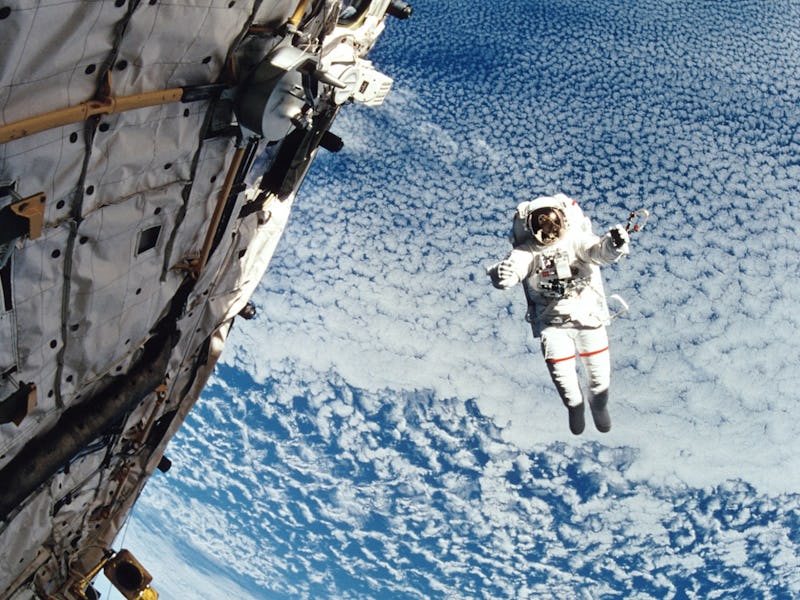What Will Actually Happen on NASA's Two Upcoming Spacewalks?
A preview of some extravehicular activity.

NASA has two important spacewalks coming up within the next couple of weeks: one on October 28, which will focus repairs and maintenance for the International Space Station, including the installation of a thermal cover on the Alpha Magnetic Spectrometer, and another on November 6, which will restore a part of the ISS cooling system back to its original configuration. The walks will be the 32nd and 33rd recorded by U.S. astronauts, but the walkers are brand new. Scott Kelly and Kjell Lindgren haven’t gone outside in space.
But what exactly goes on in a spacewalk? We know it involves astronauts putting on their spacesuits and going on a nice zero-gravity stroll in 249 miles above the Earth, but how, specifically, does NASA pull off the extraordinary feat of chilling on the outside of a million-pound space station traveling at 17,136 miles per hour?
A spacewalk — or extravehicular activity as NASA prefers to term it — is basically any instance in which an astronaut is outside of their spacecraft. The first spacewalk occurred on March 18, 1965, when Russian cosmonaut Alexi Leonov took a bold wiggle into the big beyond. That initial walk was 10 minutes long, but most spacewalks these days last anywhere between five and eight hours. The world record is eight hours and 56 minutes and belongs to NASA astronauts Jim Voss and Susan Helms.
The two upcoming EVAs should last about 6.5 hours each. The goal is to start preparing the ISS for a very busy 2016, which will see more missions involving commercial spacecraft docking with the ISS to deliver supplies and resources to the astronauts onboard. On a news conference last Thursday, NASA officials explained in greater detail what will be going on with the upcoming spacewalks — and the distilled version is basically that Kelly and Lindgren will be conducting a bunch of electrical work.
Being handymen in space is no job for a task rabbit. NASA’s protocols for each spacewalk are formulated months in advance and include details about how much torque and how many turns will be needed to tighten a bolt. Every exact step and movement are predetermined by mission control down in Houston. All astronauts prepare themselves for such missions by going through practice sessions in NASA’s Neutral Buoyancy Lab, a 6.2 million gallon tank located near the Johnson Space Center that simulates spacewalk environments and tasks. It’s one of the largest underwater facilities in the world, with a system capable of turning over the pool within 19 hours, and containing a realistic model of the ISS for training.
And, of course, some parts of the spacewalk are modified based on who is up there. For the first spacewalk, Kelly, the senior astronaut, will be in command — yet Lindgren will be assigned some of the more trickier work, all because his arms are longer than Kelly’s. (Being shorter in space pays off! Of course, as the commander, Kelly is the first one out and last one back in.)
One of the most time-consuming tasks is prepping the EVA suits for an hours-long jaunt outside the ISS. This includes flushing the suits’ cooling loops of any contaminants, and making any last minute trims or hems to fit the astronauts bodies. They’ll also need to make sure the suits will have enough oxygen and water for the mission.
Most astronauts and their tools stay tethered to the ISS during a spacewalk. But some astronauts are also fitted with what’s called SAFER (Simplified Aid for EVA Rescue) — which basically works like a jet pack to allow an astronaut to move around and get back to the space station in case they begin floating away.
Obviously, there’s a lot that can go wrong — and that’s not even indulging in an unlikely disaster scenario like in Gravity.
It’s important to remember, however, the people who do this are professionals who’ve spent their whole life preparing for these kinds of missions. On a conference last Thursday, Michael Lammers, lead Expedition 45 flight director, said both Kelly and Lindgren were “very excited” for their first spacewalks. Lammers said that Kelly, who is currently on an unprecedented one-year mission aboard the ISS, “in particular has had a long history here at NASA…So it’s particularly nice to see him have this opportunity.”
We couldn’t agree more. Stay safe dude.